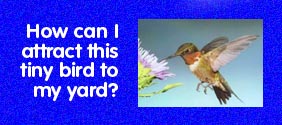This season's articles (Excerpted from our printed newsletter):
The Ruby Throated Hummingbird
There are about 340 species of hummingbirds in the world but only the Ruby Throated Hummingbird is common to our area. This tiny bird is only about 3 inches long and weighs between 6-8 grams. (102 Ruby Throated Hummingbirds weigh as much as a 12 oz. can of Coke). Its back is iridescent green with a white breast and belly. They fly up to 60 miles per hour and their wings can beat up to 75 times per second. Their eggs are ½ the size of a jelly bean which makes it the smallest egg in the bird world. Their life span is 5-6 years.
A great deal of energy is spent flying so the hummingbird must eat constantly. They can consume up to 50% of their weight in sugar each day. They usually feed on nectar, tree sap and pollen, although they also need protein and add insects and spiders to their diet. Their bills are long and tapered, perfectly suited for probing into the center of tubular flowers for nectar, which they take up at the rate of about 13 licks per second. Their tongues are grooved to collect the nectar, not hollow like a straw.
 Hummingbirds are able to perch and will do so at the feeders. Because they fly so much, they have poorly developed feet and can barely walk. They are much more comfortable in flight, which can be up, down, forward, backward, and sometimes sideways and are able to stop in midair.
Hummingbirds are able to perch and will do so at the feeders. Because they fly so much, they have poorly developed feet and can barely walk. They are much more comfortable in flight, which can be up, down, forward, backward, and sometimes sideways and are able to stop in midair.
Hummers like to take a bath on a cupped leaf or shallow dish. This allows them to preen their feathers for flight. They also enjoy flying through a water mist, either at a birdbath or sprinkler.
The easiest way to attract hummingbirds to your property is to plant a profusion of annuals, perennials and shrubs that have nectar-rich flowers, especially red tubular flowers. Once they have discovered your flowers add your feeders. Be patient; some hummers discover feeders right away and others will take longer. They are very territorial and defend flowers and feeders within their favorite roost spot. So, if you want to attract more hummers, try putting up to 2 or 3 more feeders out of sight from each other. Hang your nectar feeders in the shade, protected from wind and also near perching sites. The shade will allow the nectar to remain fresh longer and fresh nectar is very important. We also recommend hanging feeders near a window so you can watch the birds eat. Hummingbirds are so quick and agile that they quickly lose their fear of us slow-motion animals.
Feeder Frenzy: Nectar Feeders
There are 2 basic types of nectar feeders; saucers and vacuum.
Saucers are flat with holes at the top. The liquid is far enough from the hole so bees can't reach it. Some come with built-in ant traps and they are usually made of plastic.
There are 2 varieties of the gravity type feeders. The first has a liquid vessel (inverted bottle) above the feeding area. The liquid makes it way down to the feeding ports, some of which are protected with bee guards. These generally are easily monitored as to the amount of nectar remaining in the feeders and can be simple or decorative in design, made of plastic or glass. The second type of vacuum type is usually sphere-like with a plastic/glass feeding tube coming out the bottom. These feeders must be filled completely to prevent dripping and loss of nectar through the feeding tube. They are usually made of glass or pottery and rarely have any way to discourage bees.
Red nectar feeders are designed to attract hummingbirds, orange ones attract orioles. The feeders need to be cleaned frequently with hot water and the nectar changed often. Avoid soaps because of possible residue. It is recommended that you use only clear nectar, whether you purchase it or make it yourself. Red coloring has been related to kidney failure in hummingbirds and can cause birth defects.
Back to current newsletter













